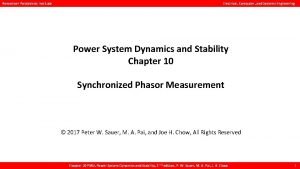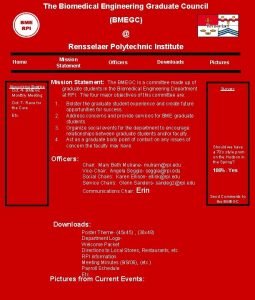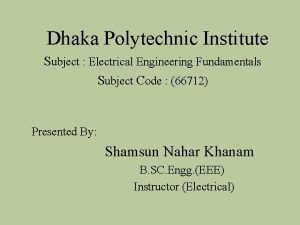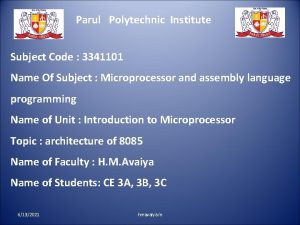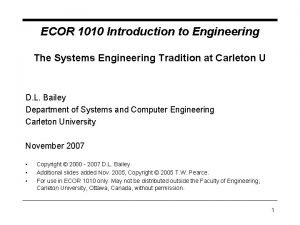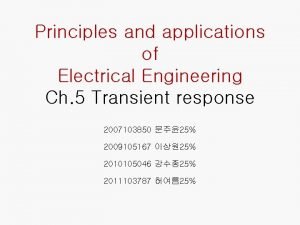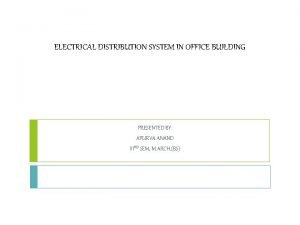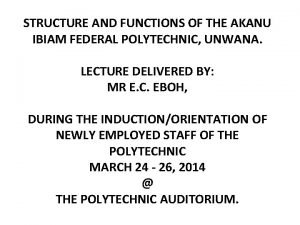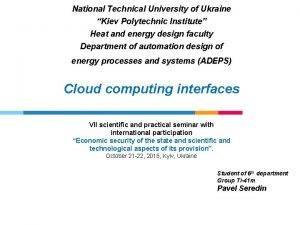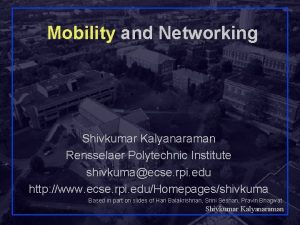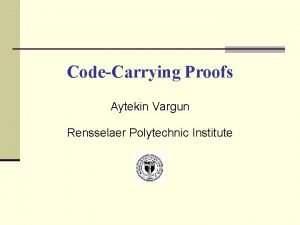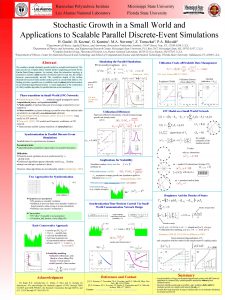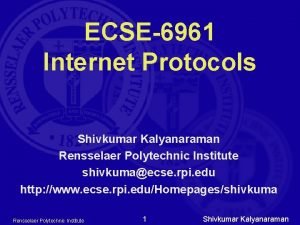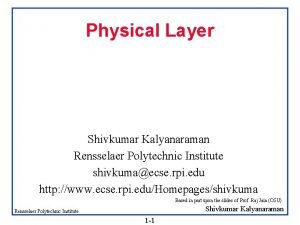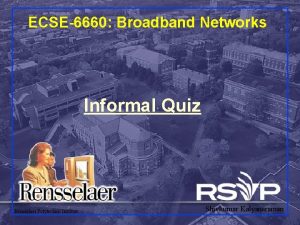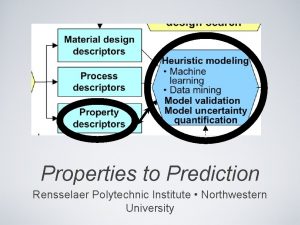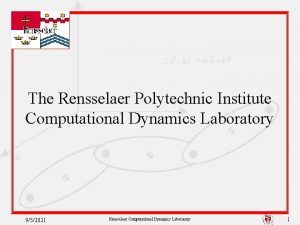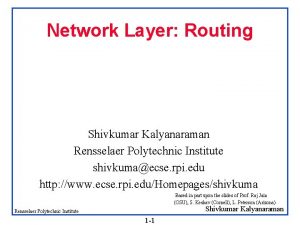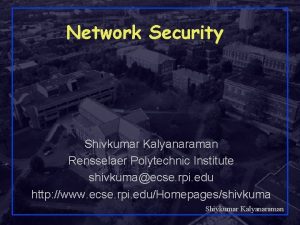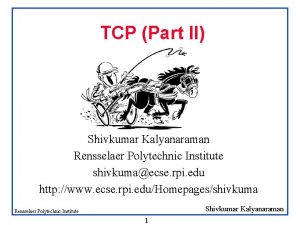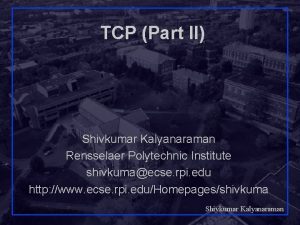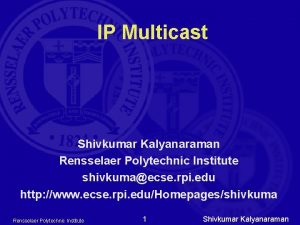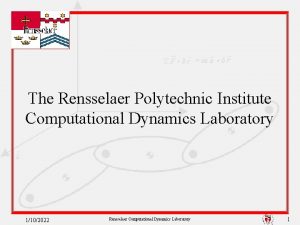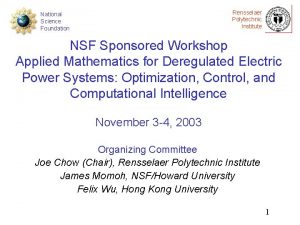Rensselaer Polytechnic Institute Electrical Computer and Systems Engineering







































- Slides: 39

Rensselaer Polytechnic Institute Electrical, Computer, and Systems Engineering Power System Dynamics and Stability Chapter 10 Synchronized Phasor Measurement © 2017 Peter W. Sauer, M. A. Pai, and Joe H. Chow, All Rights Reserved Chapter 10 PMU, Power System Dynamics and Stability, 2 nd edition, P. W. Sauer, M. A. Pai, J. H. Chow 1

Rensselaer Polytechnic Institute Electrical, Computer, and Systems Engineering Outline • Background • Phasor calculation • Phasor data communication • Power system frequency response • Power system disturbance propagation • Power system disturbance signatures • Phasor state estimation • Modal analysis of oscillations • Energy function analysis • Control design using PMU data Chapter 10 PMU, Power System Dynamics and Stability, 2 • In late 1980’s, power industry switched from analog relaying to digital relaying, as digital relaying would provide more functionalities and eventually would be cheaper to build. • With the launch of the GPS satellites (1973, originally 24 satellites), it is possible to receive a timing signal every second (accurate to within 2 microseconds) so that the measured voltage and current signals can be time tagged and collected from a wide region. nd edition, P. W. Sauer, M. A. Pai, J. H. Chow 2

Rensselaer Polytechnic Institute Electrical, Computer, and Systems Engineering Introduction • US power system: 3 -phase sinusoidal AC voltages and currents at a frequency of 60 Hz • Phase a quantities (voltages and currents) lead phase b quantities by 120 degrees, which leads phase c by 120 degrees • A sinusoidal signal can be represented by a cosine function with a magnitude A, frequency ω, and phase φ. • A is the rms value of the voltage/current signal Chapter 10 PMU, Power System Dynamics and Stability, 2 nd edition, P. W. Sauer, M. A. Pai, J. H. Chow 3

Rensselaer Polytechnic Institute Electrical, Computer, and Systems Engineering SCADA vs PMU Measurements • SCADA voltage and power measurements • V and P, Q are sampled every 5 sec. An RTU will transmit the data via modems, microwave, or internet in ICCP directly to control rooms or NERC Net. • Data from different locations are not captured at precisely the same time. However, V, P, and Q normally do not change abruptly, unless there is a large disturbance nearby. These data can be used in the State Estimator to validate the measured data and calculate the non-metered voltages and line power flows. Chapter 10 PMU, Power System Dynamics and Stability, 2 nd edition, P. W. Sauer, M. A. Pai, J. H. Chow 4

Rensselaer Polytechnic Institute Electrical, Computer, and Systems Engineering Nominal Frequency Phasor Computation • Non-recursive and recursive methods • Signal • Phasor representation (freq is implied) • Apply discrete (fast) Fourier transform • Phasor is computed as Chapter 10 PMU, Power System Dynamics and Stability, 2 • The recursive method is subject to accumulation of quantization error nd edition, P. W. Sauer, M. A. Pai, J. H. Chow 5

Rensselaer Polytechnic Institute Electrical, Computer, and Systems Engineering Off-Nominal Frequency Phasor Computation • Even though power systems operate within a narrow frequency band about the nominal frequency, system frequency is rarely at precisely the nominal frequency • Two approaches for off-nominal frequency phasor computation – Frequency tracking is more computationally intensive as it involves resampling – Frequency compensation requires computation of correction factors Frequency tracking Chapter 10 PMU, Power System Dynamics and Stability, 2 nd Frequency compensation edition, P. W. Sauer, M. A. Pai, J. H. Chow 6

Rensselaer Polytechnic Institute Electrical, Computer, and Systems Engineering Frequency Compensation Method • Chapter 10 PMU, Power System Dynamics and Stability, 2 nd edition, P. W. Sauer, M. A. Pai, J. H. Chow 7

Rensselaer Polytechnic Institute Electrical, Computer, and Systems Engineering Example: 55 Hz signal (in 60 Hz system) • Signal sampled at 1. 44 KHz. Second-harmonic component (b) (a) Chapter 10 PMU, Power System Dynamics and Stability, 2 nd edition, P. W. Sauer, M. A. Pai, J. H. Chow 8

Rensselaer Polytechnic Institute Electrical, Computer, and Systems Engineering Post Processing of Off-Nominal Frequency Phasors • The objective is to get rid of the second-harmonic component • A simple way is to use a 3 -point filter, which can be implemented as • Note that the points selected in the 3 point filter are spaced 120 degrees apart to achieve cancellation of the second-harmonic component where the magnitude is averaged as • Then the phasor is approximated by Chapter 10 PMU, Power System Dynamics and Stability, 2 nd edition, P. W. Sauer, M. A. Pai, J. H. Chow 9

Rensselaer Polytechnic Institute Electrical, Computer, and Systems Engineering Zero-(0), Positive-(1), and Negative(2)-sequence Phasors • The phasor algorithm can be used to compute the phasors for each phase: a, b, c. Then the sequence quantities are where • The sequence phasors from the measured data would be • For balanced 3 -phase operation, the second-harmonic components in the positive-sequence will cancel, resulting in • Also the negative sequence consists of mostly second-harmonic components Chapter 10 PMU, Power System Dynamics and Stability, 2 nd edition, P. W. Sauer, M. A. Pai, J. H. Chow

Rensselaer Polytechnic Institute Electrical, Computer, and Systems Engineering Frequency Estimation Chapter 10 PMU, Power System Dynamics and Stability, 2 nd edition, P. W. Sauer, M. A. Pai, J. H. Chow

Rensselaer Polytechnic Institute Electrical, Computer, and Systems Engineering Summary of Phasor Computation Chapter 10 PMU, Power System Dynamics and Stability, 2 nd edition, P. W. Sauer, M. A. Pai, J. H. Chow

Rensselaer Polytechnic Institute Electrical, Computer, and Systems Engineering Anatomy of a PMU Adapted from Arun Phadke and Ken Martin Chapter 10 PMU, Power System Dynamics and Stability, 2 nd edition, P. W. Sauer, M. A. Pai, J. H. Chow

Rensselaer Polytechnic Institute Electrical, Computer, and Systems Engineering Virginia Tech PMUs • Emergence of computer relaying: digital relays • Development of the first PMUs at Virginia Tech 1982 -1992 by Professor Arun Phadke and installed on BPA, AEP, and NYPA systems. • First commercially available PMUs made by Macrodyne (Model 1690, 16/32 channels) in the early 1990 s, and installed at US Western System, AEP, and NYPA. From Arun Phadke Chapter 10 PMU, Power System Dynamics and Stability, 2 nd edition, P. W. Sauer, M. A. Pai, J. H. Chow

Rensselaer Polytechnic Institute Electrical, Computer, and Systems Engineering Phasor Measurement Equipment Macrodyne Model 1690 Phasor Measurement Unit Arbiter Power Sentinel 1133 A Schweitzer Engineering Laboratories SEL GE N 60 Network Stability and -421 Protection, Automation, and Control Synchrophasor Measurement System ABB Phasor Measurement Unit RES 521 Mehta Tech TRANSCAN 2000 IED Chapter 10 PMU, Power System Dynamics and Stability, 2 nd edition, P. W. Sauer, M. A. Pai, J. H. Chow

Rensselaer Polytechnic Institute Electrical, Computer, and Systems Engineering Typical PMU Rack Installation From Ken Martin Front Rear Chapter 10 PMU, Power System Dynamics and Stability, 2 nd edition, P. W. Sauer, M. A. Pai, J. H. Chow

Rensselaer Polytechnic Institute Electrical, Computer, and Systems Engineering Time Synchronization • GOES (Geostationary Operational Environmental Satellite (NASA)): 25 -100 micro-second accuracy • GPS (Global Positioning System, 1973, originally 24 satellites) – 32 satellites in medium Earth orbit: 2 microsecond accuracy • IRIG-B pulses • IEEE 1588: distributed by Ethernet GPS Antenna GPS satellites (source: Wikipedia) Chapter 10 PMU, Power System Dynamics and Stability, 2 nd edition, P. W. Sauer, M. A. Pai, J. H. Chow

Rensselaer Polytechnic Institute Electrical, Computer, and Systems Engineering Phasor Data Accuracy • Phasor is a complex quantity • The total vector error accounts for both the magnitude and phase errors • where and are the real and imaginary parts of the estimated phasor • The shaded region is 1% error, as required by the latest IEEE C 37. 118 standard Chapter 10 PMU, Power System Dynamics and Stability, 2 nd edition, P. W. Sauer, M. A. Pai, J. H. Chow

Rensselaer Polytechnic Institute Electrical, Computer, and Systems Engineering MATLAB PMU Simulator Capabilities • Off-nominal frequency phasor • Unbalanced phase operation • Impact of correction factors • Process real measured raw PMU data Chapter 10 PMU, Power System Dynamics and Stability, 2 nd edition, P. W. Sauer, M. A. Pai, J. H. Chow

Rensselaer Polytechnic Institute Electrical, Computer, and Systems Engineering North America PMU Installations • Over 2500 PMUs installed as of June 2017 • Many PMUs were installed as part of the US DOE Smart Grid Investment Grant (SGIG) program Chapter 10 PMU, Power System Dynamics and Stability, 2 nd edition, P. W. Sauer, M. A. Pai, J. H. Chow

Rensselaer Polytechnic Institute Electrical, Computer, and Systems Engineering Phasor Data Communication • PMU data is collected at a substation and streamed to a phasor data concentrator (PDC) at the transmission owner (TO) • The concentrated phasor data is further streamed to a PDC at the independent system operator (ISO) • Phasor data may also be shared between ISOs • Data communications allow a wide-area view of power system dynamics and for feedback control using remote PMU signals Chapter 10 PMU, Power System Dynamics and Stability, 2 nd edition, P. W. Sauer, M. A. Pai, J. H. Chow

Rensselaer Polytechnic Institute Electrical, Computer, and Systems Engineering Power System Frequency Response • The trip of a large generating unit in a power system would cause the system frequency to drop • Atypical system frequency response for the US Western System for loss of a unit is shown on the right • From the governor response capability, the post-fault steady-state frequency is where is known as the frequency response with a unit of MW/0. 1 Hz (D is the frequency sensitivity of the aggregate load, and R is the aggregate droop of the governors) A: Pre-fault steady-state frequency B: Post-fault steady-state frequency C: Nadir Chapter 10 PMU, Power System Dynamics and Stability, 2 nd edition, P. W. Sauer, M. A. Pai, J. H. Chow

Rensselaer Polytechnic Institute Electrical, Computer, and Systems Engineering Power System Disturbance Propagation • The classical electromechanical equation can • For a large power system, the disturbance at one end of the system be modeled as a wave equation may take a few seconds to reach the other end of the system • This phenomenon can be modeled by • Propagation speed is a partial differential equation for the electromechanical model of a radial power system • Trip of Gen 1 in Fig. 10. 11 will cause a frequency wave to go from left to right • Assuming uniformly distributed inertia and reactance, define as per-unit length quantities Chapter 10 PMU, Power System Dynamics and Stability, 2 nd edition, P. W. Sauer, M. A. Pai, J. H. Chow

Rensselaer Polytechnic Institute Electrical, Computer, and Systems Engineering Power System Disturbance Propagation Generator 11 Generator 1 Wave eqn: 1/c = 0. 564 sec Simulation: travel time is 0. 53 sec Chapter 10 PMU, Power System Dynamics and Stability, 2 nd edition, P. W. Sauer, M. A. Pai, J. H. Chow

Rensselaer Polytechnic Institute Electrical, Computer, and Systems Engineering Power System Disturbance Propagation • Longer time simulation shows both incident and reflected waves • Mixing of the incident and reflected waves allows the oscillations to be “synchronized” Florida generation-load trip event showing disturbance propagation from Florida to Manitoba and Maine in a meshed network Chapter 10 PMU, Power System Dynamics and Stability, 2 nd edition, P. W. Sauer, M. A. Pai, J. H. Chow

Rensselaer Polytechnic Institute Electrical, Computer, and Systems Engineering Power System Disturbance Signatures • Loss of generation • Loss of loads (remote pumped hydro unit) Several Millstone trip events Several HVDC 1 Pole trip events Chapter 10 PMU, Power System Dynamics and Stability, 2 nd edition, P. W. Sauer, M. A. Pai, J. H. Chow

Rensselaer Polytechnic Institute Electrical, Computer, and Systems Engineering Power System Disturbance Signatures • Oscillations • Line trip and successful reclosing • Shunt switching event • Voltage collapse Chapter 10 PMU, Power System Dynamics and Stability, 2 nd edition, P. W. Sauer, M. A. Pai, J. H. Chow

Rensselaer Polytechnic Institute Electrical, Computer, and Systems Engineering Phasor State Estimation • Circuit equation for the transmission line • In Fig. 10. 24, the voltage phasors at Buses 2 and 3 and hence the current on the line between these buses can be computed. Note that this is not possible with SCADA state estimators, because the phase difference between these two buses is not measured. • In Fig. 10. 25, the voltage phasor at Bus 2 can be computed from either Bus 1 or Bus 2, allowing for least-squares approximation. Chapter 10 PMU, Power System Dynamics and Stability, 2 nd edition, P. W. Sauer, M. A. Pai, J. H. Chow

Rensselaer Polytechnic Institute Electrical, Computer, and Systems Engineering Mechanics of Linear State Estimation • Consider the 3 -bus configuration in Fig. 10. 25. • Write the 10 unknown voltage and current phasors in rectangular form as • Current flow equations in rectangular coordinates are • 12 equations for 10 unknowns: 4 V and 4 I measurements + 4 I flow eqns. • Set up linear equation Ax = b with b Chapter 10 PMU, Power System Dynamics and Stability, 2 nd edition, P. W. Sauer, M. A. Pai, J. H. Chow

Rensselaer Polytechnic Institute Electrical, Computer, and Systems Engineering Mechanics of Linear State Estimation • The A matrix is given by • More equations than unknown, so solve as a weighted least-squares problem Chapter 10 PMU, Power System Dynamics and Stability, 2 nd edition, P. W. Sauer, M. A. Pai, J. H. Chow

Rensselaer Polytechnic Institute Electrical, Computer, and Systems Engineering Modal Analyses of Oscillations Chapter 10 PMU, Power System Dynamics and Stability, 2 nd edition, P. W. Sauer, M. A. Pai, J. H. Chow

Rensselaer Polytechnic Institute Electrical, Computer, and Systems Engineering Modal Analyses of Oscillations Chapter 10 PMU, Power System Dynamics and Stability, 2 nd edition, P. W. Sauer, M. A. Pai, J. H. Chow

Rensselaer Polytechnic Institute Electrical, Computer, and Systems Engineering Modal Analysis Example • 100 th-order fit: note a large DC component removed • 2 nd-order fit Chapter 10 PMU, Power System Dynamics and Stability, 2 nd edition, P. W. Sauer, M. A. Pai, J. H. Chow

Rensselaer Polytechnic Institute Electrical, Computer, and Systems Engineering Energy Function Analysis - Review • This example demonstrates the concept of energy functions using PMU data • From Chapter 9, the total energy function is where the potential energy is and the kinetic energy is • The event: – Some control equipment malfunctioned at a generating plant – The power system can be modeled as a two-machine system – The machine inertias and the equivalent reactance between the two machines can be estimated from PMU data using the methods in [179, 180] • The measured data will clearly show that the energy function captures the electromechanical oscillations (Note that the energy function is used to determine the transient stability of power systems, which is a function of the machine swing dynamics) Chapter 10 PMU, Power System Dynamics and Stability, 2 nd edition, P. W. Sauer, M. A. Pai, J. H. Chow

Rensselaer Polytechnic Institute Electrical, Computer, and Systems Engineering Recorded PMU Data Chapter 10 PMU, Power System Dynamics and Stability, 2 nd edition, P. W. Sauer, M. A. Pai, J. H. Chow

Rensselaer Polytechnic Institute Electrical, Computer, and Systems Engineering Energy Function Plots KE PE Total Energy • Note KE and PE contain oscillations from the machine swings • Total energy does not show machine swings. Without the swings, the external stimuli are clearly visible. Chapter 10 PMU, Power System Dynamics and Stability, 2 nd edition, P. W. Sauer, M. A. Pai, J. H. Chow

Rensselaer Polytechnic Institute Electrical, Computer, and Systems Engineering Control Design using PMU Data • Effective damping of swing modes requires good controllability and observability • Using PMU data, one can obtain signals with clear swing mode content, thus improving observability • However, remote PMU data may have to be used, and thus requiring a communication system to send the data (see figure to the right) • The bottom line is that PMU data will have a time delay: data processing and storing, data transmission, … - hopefully < 100 ms • Delay in time is equivalent to phase lag in frequency domain • Thus in damping control design using PSS (Chapter 8), more phase lead will be required in the phase compensator Chapter 10 PMU, Power System Dynamics and Stability, 2 nd edition, P. W. Sauer, M. A. Pai, J. H. Chow

Rensselaer Polytechnic Institute Electrical, Computer, and Systems Engineering Example: Control Design using PMU Data • Interarea mode at 3 rad/s • Delay = 100 ms implies a phase lag • Use 1 st-order Padé approximation to model the impact of the delay • We will insert the Padé function into the feedback path of the PSS design system in Example 8. 7 and redesign the phase compensation • The original compensator has only 1 stage Chapter 10 PMU, Power System Dynamics and Stability, 2 nd edition, P. W. Sauer, M. A. Pai, J. H. Chow

Rensselaer Polytechnic Institute Electrical, Computer, and Systems Engineering Example: Control Design using PMU Data Root-locus plot with no time delay Root-locus plot with time delay but no additional phase comp Root-locus plot with time delay and additional phase lead comp Chapter 10 PMU, Power System Dynamics and Stability, 2 nd edition, P. W. Sauer, M. A. Pai, J. H. Chow
 Rensselaer polytechnic institute electrical engineering
Rensselaer polytechnic institute electrical engineering Rensselaer polytechnic institute biomedical engineering
Rensselaer polytechnic institute biomedical engineering Worcester polytechnic institute chemical engineering
Worcester polytechnic institute chemical engineering Electronic engineering polytechnic institute of surabaya
Electronic engineering polytechnic institute of surabaya Principles of complex systems for systems engineering
Principles of complex systems for systems engineering Engineering elegant systems: theory of systems engineering
Engineering elegant systems: theory of systems engineering Jhenaidah polytechnic institute
Jhenaidah polytechnic institute Lvivtech city
Lvivtech city Dhaka polytechnic institute subject
Dhaka polytechnic institute subject Kharkiv national technical university
Kharkiv national technical university 3341101
3341101 Dhaka polytechnic institute
Dhaka polytechnic institute North coast polytechnic institute
North coast polytechnic institute North coast polytechnic
North coast polytechnic Van rensselaer potter biografia
Van rensselaer potter biografia Rpi respite
Rpi respite Klipsch school of electrical and computer engineering
Klipsch school of electrical and computer engineering Tum department of electrical and computer engineering
Tum department of electrical and computer engineering System procurement process in software engineering
System procurement process in software engineering Ecor 1010
Ecor 1010 Electrical estimate and costing
Electrical estimate and costing Principle and application of electrical engineering
Principle and application of electrical engineering Principles and applications of electrical engineering
Principles and applications of electrical engineering Allan
Allan Rising main distribution system
Rising main distribution system Vidhyadeep institute of engineering and technology
Vidhyadeep institute of engineering and technology Mandava institute of engineering and technology
Mandava institute of engineering and technology Belgium education system
Belgium education system Chandil polytechnic
Chandil polytechnic Army polytechnic school
Army polytechnic school Organogram of a polytechnic
Organogram of a polytechnic Pnrpu
Pnrpu Tomsk polytechnic university rector
Tomsk polytechnic university rector Tomsk polytechnic university rector
Tomsk polytechnic university rector Kombolcha polytechnic college
Kombolcha polytechnic college Army polytechnic school
Army polytechnic school Force exerted by jet on moving plate formula
Force exerted by jet on moving plate formula Kiev polytechnic university
Kiev polytechnic university Eija kalliala
Eija kalliala Tomsk polytechnic university rector
Tomsk polytechnic university rector
